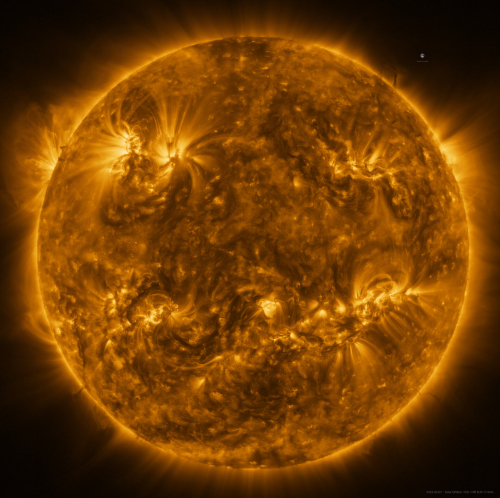Scientists pinpoint the origin of the energetic electrons thrown out by the Sun
Using Europe’s Solar Orbiter probe, scientists have now successfully identified the two sources of the energetic electrons accelerated at high speed by the Sun, and in doing so also determined why those particles sometimes arrive later than expected.
The Sun is the most energetic particle accelerator in the Solar System. It whips up electrons to nearly the speed of light and flings them out into space, flooding the Solar System with so-called ‘Solar Energetic Electrons’ (SEEs). Researchers have now used Solar Orbiter to pinpoint the source of these energetic electrons and trace what we see out in space back to what’s actually happening on the Sun. They find two kinds of SEE with clearly distinct stories: one connected to intense solar flares (explosions from smaller patches of the Sun’s surface), and one to larger eruptions of hot gas from the Sun’s atmosphere (known as ‘coronal mass ejections’, or CMEs).
“We see a clear split between ‘impulsive’ particle events, where these energetic electrons speed off the Sun’s surface in bursts via solar flares, and ‘gradual’ ones associated with more extended CMEs, which release a swell of particles over longer periods of time and over broader angular ranges,” says lead author Alexander Warmuth of the Leibniz Institute for Astrophysics Potsdam (AIP), Germany.
The researchers observed 300 events between November 2020 and December 2022 at many different distances from the Sun, allowing them to clock their travel times. The graphic above illustrates what they found.
Using Europe’s Solar Orbiter probe, scientists have now successfully identified the two sources of the energetic electrons accelerated at high speed by the Sun, and in doing so also determined why those particles sometimes arrive later than expected.
The Sun is the most energetic particle accelerator in the Solar System. It whips up electrons to nearly the speed of light and flings them out into space, flooding the Solar System with so-called ‘Solar Energetic Electrons’ (SEEs). Researchers have now used Solar Orbiter to pinpoint the source of these energetic electrons and trace what we see out in space back to what’s actually happening on the Sun. They find two kinds of SEE with clearly distinct stories: one connected to intense solar flares (explosions from smaller patches of the Sun’s surface), and one to larger eruptions of hot gas from the Sun’s atmosphere (known as ‘coronal mass ejections’, or CMEs).
“We see a clear split between ‘impulsive’ particle events, where these energetic electrons speed off the Sun’s surface in bursts via solar flares, and ‘gradual’ ones associated with more extended CMEs, which release a swell of particles over longer periods of time and over broader angular ranges,” says lead author Alexander Warmuth of the Leibniz Institute for Astrophysics Potsdam (AIP), Germany.
The researchers observed 300 events between November 2020 and December 2022 at many different distances from the Sun, allowing them to clock their travel times. The graphic above illustrates what they found.






